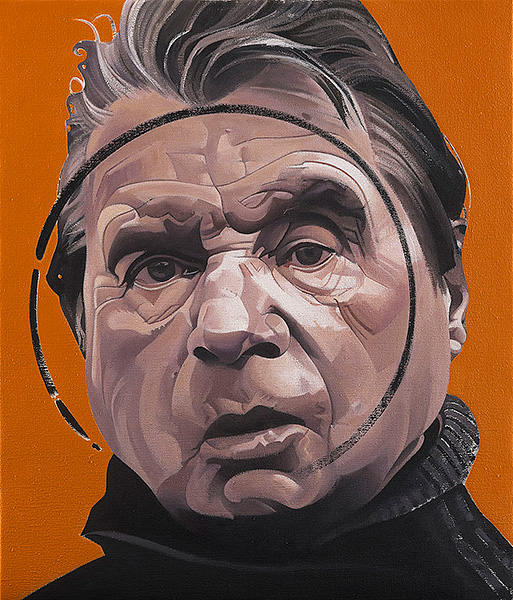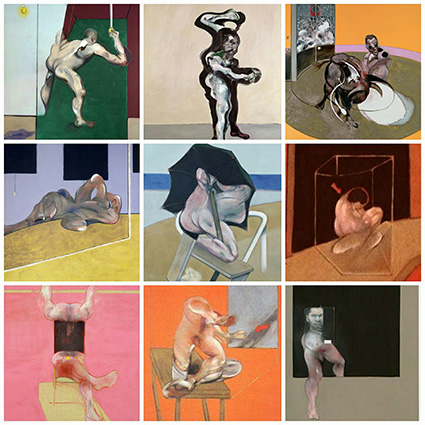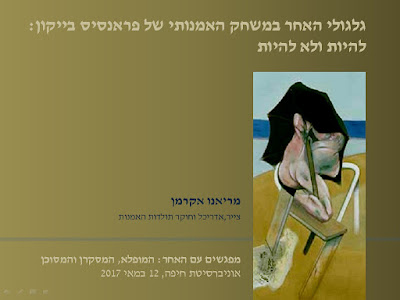1

Tiko Kerr
Walt Disney contemplando a Francis Bacon
collage, 2017
2







Texto de John Berger, inicialmente publicado en inglés como "Francis Bacon and Walt Disney", 1972; traducción española de Pilar Vázquez Álvarez, Francis Bacon y Walt Disney, incluida en: Mirar, Modos de ver y Otra manera de contar.
3

Michael Leventis, Francis Bacon, 2013
4
Though one can readily see the gravity and depth of Bacon’s characters and environments, Berger intimates that such reality is not the case in his works. Berger compares Walt Disney and his sense of over the top cartoon animation to Bacon’s work on the basis that both are hollow and lack substance. He even states that Bacon’s work is in line with the repetitive Disney pieces in that, “Bacon’s paintings do not comment, as is often said, on any actual experience of loneliness, anguish or metaphysical doubt; nor do they comment on social relations, bureaucracy, industrial society or the history of the 20th century…What they do is to demonstrate how alienation may provoke a longing for its own absolute form- which is mindlessness” (Berger).
Berger espouses the notion that Bacon’s work is in and of itself hollow and unquestioning. He feels that the paintings reveal little or nothing about a given subject and that the body of work has lacked thematic development. Berger even goes so far as to mock Bacon by referring to his own words when he mentions that all objects other than bodies are illustrated, something that Bacon has said he find boring about works that appeal directly to the brain rather than the nervous system. In effect, Berger is purposely equating the works of Bacon to that which Bacon most disliked about conventional art in order to provide a dramatic sense of invalidation to the pieces.
While John Berger may think himself clever for attempting to render Bacon as artistically and intellectually flaccid, he is far from convincing in his comparison of his works to that of Disney. Walt Disney presents what is obviously a bland and stereotypical cast of characters, all of whom play out absurdly over simplified story lines in slapstick. The moral and ethical depth of said stories are best compared to a mirror; illusionary, superficial, and nonexistent in actuality. No gray area is permitted in right and wrong in the magic kingdom. Good guys win because they are good and baddies are conversely wrong as such. The great notion of human struggle and the despair of human experience is limited to songs and silliness. The fact that these stories are often to violent for children does not negate the fact that they are created solely for their consumption. Little substance beyond basic prescription for general moral principles and values like sharing, honesty, and friends sticking together can be found in these films. Quite literally, the Disney catalog is devoid of intricacy of any kind aside from the physical talent of the illustrators themselves.
One may argue that only the actual physical art and image matters in this case. I reject this assertion as art intrinsically involves narrative. The story of a piece is of the utmost importance in experiencing the work. This being true, Bacon’s paintings are rife with rich and intricate narrative. No piece in his body can be seen without calling into question a plethora of factors involved in the character’s expression. Though Bacon’s art focuses singularly on pain and suffering this does not in-substantiate is presence. Singularity of subject does not impinge upon the effectiveness of its conveyance in a given medium. Where Berger would argue that Bacon’s work shows no growth of theme, one can easily see that the theme involved is developed throughout the life of his work. The expression of pain and grief of Bacon’s earliest works are obvious predecessors to his later pieces. His ability to convey the notions have been studied and fine tuned to a point where they do enter directly in to the nervous system as he would have hoped. A question of thematic development can not and should not hinder the appreciation of any artistic body. These facts separate Bacon from Disney absolutely as his work transcends triviality and even the medium that it utilizes to offer the audience a direct interaction with not just the image of the raw human condition, but also a direct experience.
Bacon’s work has a depth that Berger seems to have missed in his rush to make an interesting comparison. For Bacon’s art hits upon key truths of the pain of humanity. Though Berger would say that the art reveals nothing, much is actually exposed. The most important of these exposures, is the raw reality that while we are most certainly alive (and aware of that fact) we are, at the very same time, most certainly dying. Berger may see the art of Francis Bacon as illustrative, but what one may find better illustrated by further examination is a definite sense that Berger is still unaware of this fact. For, while his pontificating may be very lively, his argument is surely dead.
Ian Little, Reflection upon Berger, 28.1.2011
Berger espouses the notion that Bacon’s work is in and of itself hollow and unquestioning. He feels that the paintings reveal little or nothing about a given subject and that the body of work has lacked thematic development. Berger even goes so far as to mock Bacon by referring to his own words when he mentions that all objects other than bodies are illustrated, something that Bacon has said he find boring about works that appeal directly to the brain rather than the nervous system. In effect, Berger is purposely equating the works of Bacon to that which Bacon most disliked about conventional art in order to provide a dramatic sense of invalidation to the pieces.
While John Berger may think himself clever for attempting to render Bacon as artistically and intellectually flaccid, he is far from convincing in his comparison of his works to that of Disney. Walt Disney presents what is obviously a bland and stereotypical cast of characters, all of whom play out absurdly over simplified story lines in slapstick. The moral and ethical depth of said stories are best compared to a mirror; illusionary, superficial, and nonexistent in actuality. No gray area is permitted in right and wrong in the magic kingdom. Good guys win because they are good and baddies are conversely wrong as such. The great notion of human struggle and the despair of human experience is limited to songs and silliness. The fact that these stories are often to violent for children does not negate the fact that they are created solely for their consumption. Little substance beyond basic prescription for general moral principles and values like sharing, honesty, and friends sticking together can be found in these films. Quite literally, the Disney catalog is devoid of intricacy of any kind aside from the physical talent of the illustrators themselves.
One may argue that only the actual physical art and image matters in this case. I reject this assertion as art intrinsically involves narrative. The story of a piece is of the utmost importance in experiencing the work. This being true, Bacon’s paintings are rife with rich and intricate narrative. No piece in his body can be seen without calling into question a plethora of factors involved in the character’s expression. Though Bacon’s art focuses singularly on pain and suffering this does not in-substantiate is presence. Singularity of subject does not impinge upon the effectiveness of its conveyance in a given medium. Where Berger would argue that Bacon’s work shows no growth of theme, one can easily see that the theme involved is developed throughout the life of his work. The expression of pain and grief of Bacon’s earliest works are obvious predecessors to his later pieces. His ability to convey the notions have been studied and fine tuned to a point where they do enter directly in to the nervous system as he would have hoped. A question of thematic development can not and should not hinder the appreciation of any artistic body. These facts separate Bacon from Disney absolutely as his work transcends triviality and even the medium that it utilizes to offer the audience a direct interaction with not just the image of the raw human condition, but also a direct experience.
Bacon’s work has a depth that Berger seems to have missed in his rush to make an interesting comparison. For Bacon’s art hits upon key truths of the pain of humanity. Though Berger would say that the art reveals nothing, much is actually exposed. The most important of these exposures, is the raw reality that while we are most certainly alive (and aware of that fact) we are, at the very same time, most certainly dying. Berger may see the art of Francis Bacon as illustrative, but what one may find better illustrated by further examination is a definite sense that Berger is still unaware of this fact. For, while his pontificating may be very lively, his argument is surely dead.
Ian Little, Reflection upon Berger, 28.1.2011























